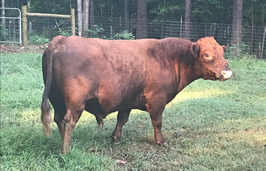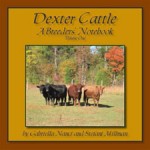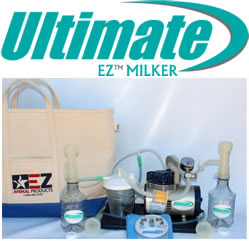Is my cow in proper condition?
Many Dexter breeders are new to cattle. This means we must offer a lot of technical support to our buyer, and we need to be careful how we promote the breed. Breeders: please, please, please do not advertise Dexters as “able to thrive on poor pasture.” This sentence is way too open to interpretation and we have rescued more starving cattle from novice breeders than we can count; simply because they didn’t know better. We have actually seen Dexters starved to death. Every year, there are starving animals actually in the show ring at the National Show and Sale; people whisper but nobody turns the animals away from the show because they figure it is better they sell and find a new home. This does not happen with any other breed. We have to stop advertising Dexters this way, and must start educating people about proper body condition.
One problem is that many people think a big belly means the cow is fat. This is not true, a big belly can be a sign of poor nutrition, chondrodysplasia (dwarfism), parasites, old age, pregnancy, or eating dirt. An animal can be underweight and have a big belly. You really have to look at the boney structure of the animal to determine its body condition.
Many of us are having problems with poor pasture, high hay prices, etc, which has led to changes in feed. Over the years, I have encountered the two extremes of the feed problem, in two different herds.
“Breeder A” had cows on rough grazing and was told that, being Dexters, the animals would “make due.” The cows had grazed the grass down to the nubs. This was certainly “poor pasture,” but hese animals were not thriving. When I saw them, most of their ribs were visible and they had coarse, shaggy coats. The animals had a very angular appearance and reminded me of large black Halloween cats. About half the cows had failed to produce calves, even though they had been with the bull. The yearling calves were the size of four month old calves. The animals were expected to fend for themselves, and the breeder did not know about supplements such as protein tubs that can be placed in the pasture once a month; allowing supplementation without daily maintenance. These animals would have looked a lot different and produced better with proper supplementation. As it turned out, of the two cows that were pregnant, even after the cows were properly fed at the end of their gestation and gained weight, the calves that were starved in utero did not grow at the same rate as calves who were carried by cows receiving normal nutrition. They also had crooked legs.
“Breeder B” was dismayed that two out of three of his new animals had calving problems. This surprised me, as my own herd has had only a couple calving problems in 20 years. But then, I went to look at his cows. Due to lack of pasture, the animals had been penned in 24 foot pipe corrals and were free-fed alfalfa. The cows were morbidly obese and lacked any sort of muscle tone. Obese cattle in any breed are notorious for calving difficulties, as are confined cattle that receive little exercise. There is even something known as Fat Cow Syndrome that can include a range of health problems such as calving difficulty, retained placenta, inflammation of the uterus, fatty liver, displaced stomach, mastitis, ketosis and milk fever.
We all have a certain amount of “Barn Blindness,” (everything in our barn is beautiful). The following table is a useful tool to help us judge the condition of our cattle. Most of animals in Breeder A’s herd would have scored a 2 (Poor Condition). The cows in Breeder B’s herd would have scored 8 or 9 (Fat or Extremely Fat).
Feed problems are something we all have to deal with, and breeders should be not be embarrassed to ask other breeders to score their cattle’s weight, or to give pointers on how they provided for their animals during drought, mud, hay price increases, and other changing factors. Local knowledge is often especially helpful, as the challenges may be similar, and similar solutions may be available in the way of supplements. You may also be able to contact the local Agriculture Extension office.
Table 1. System of Body Condition Scoring (BCS) for Beef Cattle
BCS Description
Thin Condition
- EMACIATED – Cow is extremely emaciated with no palpable fat detectable over spinous processes, transverse processes, hip bone or ribs. Tail-head and ribs project quite prominently.
- POOR – Cow still appears somewhat emaciated but tail-head and ribs less prominent. Individual spinous processes are still rather sharp to the touch but some tissue cover exists along the spine.
Borderline Condition
- THIN – Ribs are still individually identifiable but not quite as sharp to the touch. There is obvious palpable fat along spine and over tail-head with some tissue cover over dorsal portion of ribs.
- BORDERLINE – Individual ribs are no longer visually obvious. The spinous processes can be identified individually on palpation but feel rounded rather than sharp. Some fat cover over ribs, transverse processes and hip bones.
Optimum/Moderate Condition
- MODERATE – Cow has generally good overall appearance. Upon palpation, fat cover over ribs feels spongy and areas on either side of tail-head now have palpable fat cover.
- HIGH MODERATE – Firm pressure now needs to be applied to feel spinous processes. A high degree of fat is palpable over ribs and around tail-head.
- GOOD – Cow appears fleshy and obviously carries considerable fat. Very spongy fat cover over ribs and around tail-head. In fact, “rounds” or “pones” beginning to be obvious. (Pones are protruding fat deposits.) Some fat around vulva and in crotch.
Fat Condition
- FAT – Cow very fleshy and over-conditioned. Spinous processes almost impossible to palpate. Cow has large fat deposits over ribs, around tail-head and below vulva. “Rounds” or “pones” are obvious.
- EXTREMELY FAT – Cow obviously extremely wasty and patchy and looks blocky. Tail-head and hips buried in fatty tissue and “rounds’ or “pones” of fat are protruding. Bone structure no longer visible and barely palpable. Animal’s mobility may even be impaired by large fatty deposits.
(BCS scoring was originally published by Richards, M.W., J.C. Spitzer and M.B. Warner. 1986. J. Anim. Sci. 62:300.)
There is a great resource published by the Virginia Tech Cooperative Extension (with photos) here.



hello
i was wondering if you can help me
i have a 4 mnth old murry grey strear he was ringed at 2 weeks old no problems
he was weaned around 2 mnths of age , he was grazing and eating grain all ok
i was giving i ltr a sup milk for 1 week after weaning the he stopped coming in all the time so i stopped the milk
his growing has changed he was growing good , now he dosnt seem to growing in size except for his Big belly , he is very short legged, and looks like a barrel
he has been wormed , they were getting probiotic,,
we did have coccididty , he didnt show any signs or scours
question is , is there anything i can do now , there grazing draught condition , grass with new shoots , in a large paddock and some small amount of hay when they come in or will he grow into his stomach, it looks big on both sides a little different on left side
ant suggestions
thanks
michelle
He may be eating too much dirt. That is common in poor grazing conditions. If there is any way you can get a protein tub out to him, that often solved the problem for breeders in CA where the issue was similar. I think the media of the tub helps them move the dirt along their digestive tract, and the protein and minerals in the tub help with the deficiencies that come with eating dirt. Sorry I took so long to answer, I was out of the country.
I have a 6 year old Dexter, that after reading your article above I have come to conclude that she comes in under the ‘exteremely fat’ category. What can I do to get her in better condition, because I am very worried what health problems may be caused if I do not get her weight under control.
Any suggestions?
Thanks, Rachael
How are you feeding her, and how much space does she have? Is she a shortleg, or does she have issues with arthritis/mobility? Is she grazing or being fed hay? Without knowing any of the details, I could suggest an easy way to get cows to exercise more is to put the feed at one far end of the pasture and the water at the opposite end. I might be able to help more if I knew more about her.
I have a miniature jersey 4 year old jersey cow we AI her 3 times and bred her to a Dexter bull NO pregnancy she has developed a huge barrel belly she is on good pasture and gets 3 cups of cracked corn and whole oats a day. I feel she is to fat what do you suggest.
She may have cystic ovaries. Sometimes it is easily treated. I would try to find an embryologist or cattle vet that does “ovary work.” It may be as simple as a couple of injections, or it may be hopeless, but at least you will know.
I had recently had my cow die because of her not eating. She has eaten very well this summer but not enough to get some meat on her bones. Ever since the cold started she hasnt eaten, I seperated her from the rest of the herd and i took the calf off her because she wasnt producing milk well enough to feed the calf. I fed her some left over stuff from the brewery to fatten her up, but she wouldnt even touch. she would every once in a while eat but not enough.
-Hayden Zimpel
So sorry about your cow. Without a necropsy, it is hard to guess what caused her death. Most likely, she stopped eating because something else was wrong; so anorexia was a sign of illness, but not the cause of her death. There are so many possibilities, infectious causes like Johne’s or even mycoplasma, environmental causes like fatty necrosis, or hardware disease; partial bowel obstruction; she could have even had cancer. You will most likely never know, but if you have any other animals with similar symptoms, I would definitely call a vet.
I have a belted Galloway highland cross. He’s castrated and is a pet in a pasture with a couple mini horses. His belly is huge and I noticed him breathing more heavily. We are already at 85 here on Georgia. I bought him from a well known petting zoo at 7 months as a mini. He’s definitely not a mini , maybe a midline. I just can’t find a lot of info on care as s pet. I was instructed to feed sweet feed which I don’t think is right. Noticed he’s drinking more water (prob bc hot). Considering getting him a friend as the vet stated cows need cows. Trimming up his coat and using thinning shears. Any advice welcomed!!
Some of my cows are very bony in the rear and hips. I provide protein tub and a good grade of hay. The pastures are eaten down. What and how can I feed them to put the weight back on them. I look forward to your respond. Thanks
When the pastures are overgrazed, it is much easier for them to contract intestinal parasites. Have you de-wormed them?